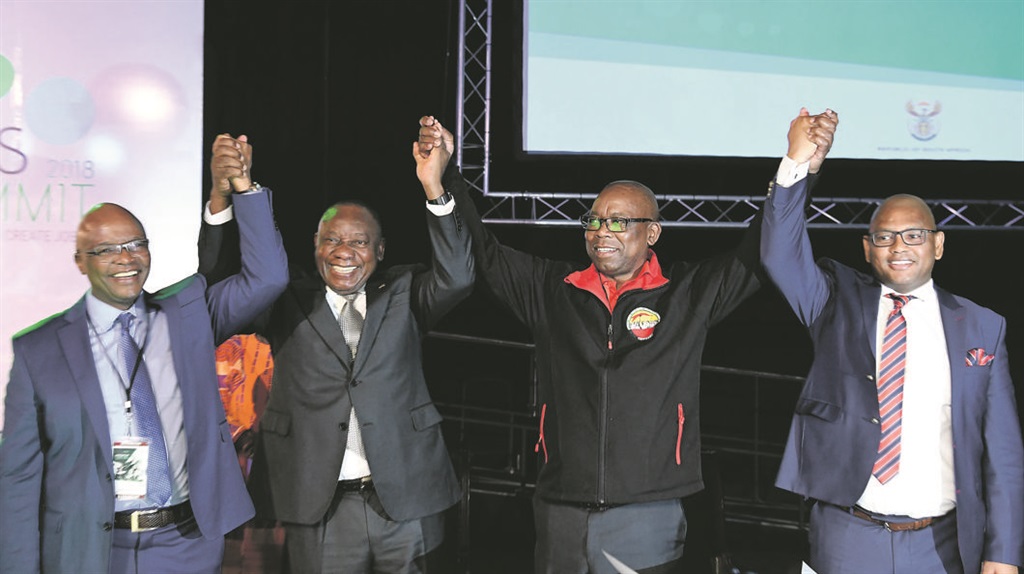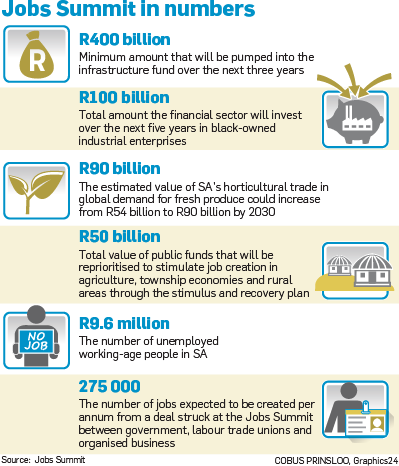
The government is looking to subsidise certain industries in order to create jobs, according to President Cyril Ramaphosa’s 84-page framework agreement, which was unveiled at the Jobs Summit this week.
There are a number of significant proposals that would see the government put money on the table through guarantees and incentives.
One proposal that stuck inconspicuously in the agreement’s section dealing with the metals and machinery sector is that subsidised electricity for heavy industry may be considered.
Offering electricity at “developmental prices” is listed as a critical factor for success in the sector.
Two proposed interventions involve government subsidising loans made by commercial banks to the manufacturing sector.
In order to achieve “better priced industrial finance”, the agreement calls for an “interest make-up facility” through which the state will apparently pay a part of industrial lenders’ interest payments.
In order to achieve longer repayment terms for industrial lenders, the agreement also calls for a “guarantee facility” – again funded by government – that allows banks to give loans with longer repayment terms.
This would see the state extend guarantees to the private sector.
YOUTH WAGE SUBSIDY
One commitment that could conceivably cost billions of rands is to massively expand the youth wage subsidy, formally known as the Employment Tax Incentive (ETI).
The ETI currently offers subsidies for first-time workers under 29 years old earning less than R6 000 a month.
On that basis, Treasury data suggests that about R16 billion has been spent on this incentive since it launched in 2014 up to July this year.
This week’s agreement calls for it to be extended by 10 years, but also for its value to be reviewed “subject to the availability of funds”.
The agreement calls for the ETI to extend its coverage to workers up to the age of 35 and for the cut-off wage to be raised to R8 000.
This should increase the tax expenditure on the subsidy significantly.
Because workers can only be subsidised for two consecutive years, the ETI’s cost initially spiked, then started to decline.
It cost R4.6 billion in the 2016-2017 financial year, but only R4.1 billion in the 12 months up to March this year.
The ETI was the foundation of the Youth Employment Service programme championed by the CEO Initiative, and is very popular with organised business.
While the government has published research based on tax records indicating that the ETI has not led to the displacement of older workers, it has still not demonstrated that the ETI actually creates jobs instead of causing a so-called dead-weight loss by subsidising jobs that would exist anyway.
Many sections of the agreement simply record that the social partners will continue to work on existing policies.
In a press release following the summit, the presidency highlighted the creation of a fund to invest a total of R100 billion into black-owned manufacturing companies over five years.
This is, however, an outcome of the Financial Sector Code negotiated in December last year.
The agreement also endorses private sector proposals that have been on ice for years, but finally seem to have found favour under the Ramaphosa administration.
Among the main “blended finance” proposals in the agreement is a 50/50 government grant and government loan scheme proposed by the Agricultural Business Chamber and the Banking Association of SA to fund land reform.
This dates from 2015, but had been consistently rebuffed by government.
JOB MATHS DOESN’T ADD UP
In his speech at the summit this week, Ramaphosa said that the measures contained in the agreement “will create an additional 275 000 direct jobs a year ... over and above the jobs that would have been created without these interventions, which was on average about 300 000 a year over the past four years”.
The basis of this estimate was not explained.
He also said that the National Development Plan (NDP) target of 6% unemployment by 2030 was unlikely to be achieved “unless we do something extraordinary”.
The National Planning Commission (NPC), which crafted the NDP, has less rosy projections. A recent, unreleased evaluation paper produced by the commission, which was revealed by City Press last week, estimated that the absolute best South Africa could hope for is a 14% unemployment rate in 2030.
That was subject to an unlikely confluence of positive events.
The NPC paper also contradicts Ramaphosa’s job numbers.
Instead of 300 000 jobs per year appearing over the past four years, the NPC paper cites an average of 182 000 jobs per year in 2015 to 2017.
WHAT ABOUT THE LAND?
The agreement makes no mention of land expropriation, except to say that government is working on its new “draft redistribution policy and bill”.
The sections on land reform are mostly preoccupied with organising finance from banks and getting established commercial farmers to partner with emerging black ones.
A section of the agreement detailing “inclusive growth interventions” calls for a politically significant system for companies to report pay ratios and reveal the wage gaps between its employees.
This is, however, emphatically voluntary, at least at first.
The agreement does call for the JSE to be engaged to “assess the feasibility of mandatory reporting of pay ratios”.
While the agreement reiterates that government will not retrench any workers, business would only commit to a paragraph reading “everything possible must be done to avoid retrenchments”.
The agreement promises to establish “rapid response teams” to provide “affordable” turnaround services to businesses in crisis which might retrench.
While the agreement sees government promise to more seriously “designate” sectors for local procurement, business promised to let government’s list of designated products “inform” its own procurement.
 |
| ||||||||||||
| |||||||||||||




 Publications
Publications
 Partners
Partners









